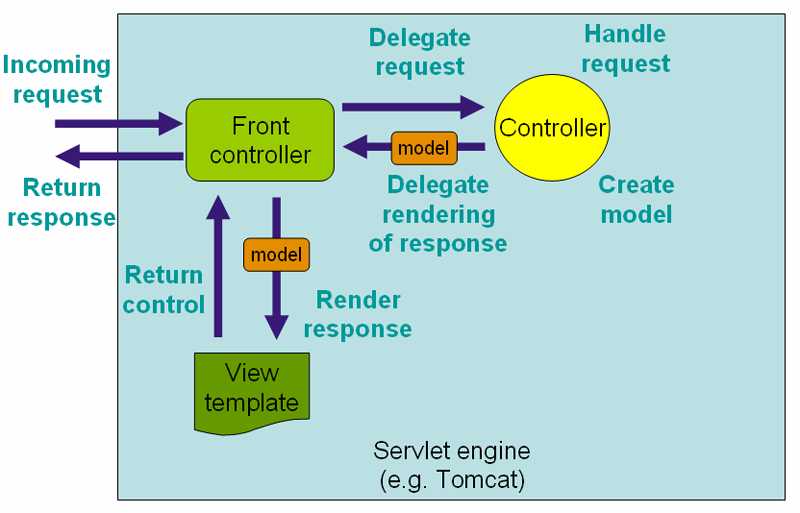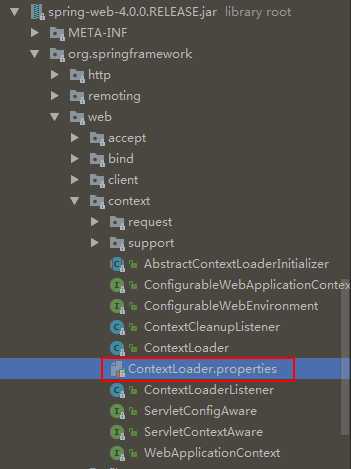标签:efault state attr initial pat create term control defaults
SpringMVC源码学习笔记(一)
前言----
最近花了些时间看了《Spring源码深度解析》这本书,算是入门了Spring的源码吧。打算写下系列文章,回忆一下书的内容,总结代码的运行流程。推荐那些和我一样没接触过SSH框架源码又想学习的,阅读郝佳编著的《Spring源码深度解析》这本书,会是个很好的入门。
进入正文,首先贴上SpringMVC的图片(来自https://docs.spring.io/spring/docs/current/spring-framework-reference/html/mvc.html)

SpringMVC的大致流程就是 request -> DispatcherServlet -> HandlerMapping -> Controller -> ModelAndView -> ViewResolver ->
View, 稍微学习过的同学应该都很熟悉了,源码的学习也是根据SpringMVC的流程一步步深入的。
使用SpringMVC的标配: web.xml 文件中 DispatcherServlet 和 contextConfigLocation 和 ContextLoaderListener 的配置
1 <!-- 配置启动 IOC 容器的 Listener --> 2 <context-param> 3 <param-name>contextConfigLocation</param-name> 4 <param-value>classpath:applicationContext.xml</param-value> 5 </context-param> 6 7 <listener> 8 <listener-class>org.springframework.web.context.ContextLoaderListener</listener-class> 9 </listener> 10 11 <!-- 配置 SpringMVC 的 DispatcherServlet --> 12 <servlet> 13 <servlet-name>springDispatcherServlet</servlet-name> 14 <servlet-class>org.springframework.web.servlet.DispatcherServlet</servlet-class> 15 <load-on-startup>1</load-on-startup> 16 </servlet> 17 18 <servlet-mapping> 19 <servlet-name>springDispatcherServlet</servlet-name> 20 <url-pattern>/</url-pattern> 21 </servlet-mapping>
其中,ContextLoaderListener 实现了 ServletContextListener , 重写了contextInitialized() 方法。
1 public class ContextLoaderListener extends ContextLoader implements ServletContextListener {
2 public ContextLoaderListener() {
3 }
4
5 public ContextLoaderListener(WebApplicationContext context) {
6 super(context);
7 }
8
9 public void contextInitialized(ServletContextEvent event) {
10 this.initWebApplicationContext(event.getServletContext()); //初始化 WebApplicationContext
11 }
12
13 public void contextDestroyed(ServletContextEvent event) {
14 this.closeWebApplicationContext(event.getServletContext());
15 ContextCleanupListener.cleanupAttributes(event.getServletContext());
16 }
17 }
在父类 ContextLoader 中有 initWebApplicationContext() 该方法的定义。
1 public WebApplicationContext initWebApplicationContext(ServletContext servletContext) {
2 if(servletContext.getAttribute(WebApplicationContext.ROOT_WEB_APPLICATION_CONTEXT_ATTRIBUTE) != null) { // 第一步: 存在性验证
3 throw new IllegalStateException("Cannot initialize context because there is already a root application context present - check whether you have multiple ContextLoader* definitions in your web.xml!");
4 } else {
5 Log logger = LogFactory.getLog(ContextLoader.class);
6 servletContext.log("Initializing Spring root WebApplicationContext");
7 if(logger.isInfoEnabled()) {
8 logger.info("Root WebApplicationContext: initialization started");
9 }
10
11 long startTime = System.currentTimeMillis();
12
13 try {
14 if(this.context == null) { // 第二步:初始化context
15 this.context = this.createWebApplicationContext(servletContext);
16 }
17
18 if(this.context instanceof ConfigurableWebApplicationContext) {
19 ConfigurableWebApplicationContext cwac = (ConfigurableWebApplicationContext)this.context;
20 if(!cwac.isActive()) {
21 if(cwac.getParent() == null) {
22 ApplicationContext parent = this.loadParentContext(servletContext);
23 cwac.setParent(parent);
24 }
25
26 this.configureAndRefreshWebApplicationContext(cwac, servletContext);
27 }
28 }
29 // 第三步: 记录在servletContext中
30 servletContext.setAttribute(WebApplicationContext.ROOT_WEB_APPLICATION_CONTEXT_ATTRIBUTE, this.context);
31 ClassLoader ccl = Thread.currentThread().getContextClassLoader();
32 if(ccl == ContextLoader.class.getClassLoader()) {
33 currentContext = this.context;
34 } else if(ccl != null) {
35 currentContextPerThread.put(ccl, this.context); //第四步: 放到当前线程中
36 }
37 }
38
39 return this.context;
在第二步中, createWebApplicationContext() 方法创建了 WebApplicationContext实例。
1 protected WebApplicationContext createWebApplicationContext(ServletContext sc) {
2 Class<?> contextClass = this.determineContextClass(sc); //第一步: 获取Class 的类型
3 if(!ConfigurableWebApplicationContext.class.isAssignableFrom(contextClass)) { //第二步: 判断类型
4 throw new ApplicationContextException("Custom context class [" + contextClass.getName() + "] is not of type [" + ConfigurableWebApplicationContext.class.getName() + "]");
5 } else {
6 return (ConfigurableWebApplicationContext)BeanUtils.instantiateClass(contextClass); //第三步: 反射创建实例
7 }
8 }
在第一步中, determineContextClass() 获取了 WebApplicationContext 的Class类型。
protected Class<?> determineContextClass(ServletContext servletContext) {
String contextClassName = servletContext.getInitParameter("contextClass"); //第一步: 获取属性
if(contextClassName != null) {
try {
return ClassUtils.forName(contextClassName, ClassUtils.getDefaultClassLoader()); //第二步: 属性不为空, 反射创建
} catch (ClassNotFoundException var4) {
throw new ApplicationContextException("Failed to load custom context class [" + contextClassName + "]", var4);
}
} else {
contextClassName = defaultStrategies.getProperty(WebApplicationContext.class.getName()); //第三步: 属性为空,则从配置文件中加载
try {
return ClassUtils.forName(contextClassName, ContextLoader.class.getClassLoader());
} catch (ClassNotFoundException var5) {
throw new ApplicationContextException("Failed to load default context class [" + contextClassName + "]", var5);
}
}
}
代码比较简单, 主要是 defaultStrategies.getProperty() 的来源。 在 ContextLoader 中 静态代码块中,初始化了 该属性, 并加载了配置文件。
static {
try {
ClassPathResource resource = new ClassPathResource("ContextLoader.properties", ContextLoader.class);
defaultStrategies = PropertiesLoaderUtils.loadProperties(resource);
} catch (IOException var1) {
throw new IllegalStateException("Could not load ‘ContextLoader.properties‘: " + var1.getMessage());
}
currentContextPerThread = new ConcurrentHashMap(1);
}
ContextLoader.properties 位置。

经过以上步骤, SpringMVC 已经初始化完 WebApplicationContext 并设置在 ServletContext 中, 并放入当前线程。 接下来下一篇进入DispatcherServlet 的处理中。
本来想只粘贴关键的代码, 但觉得少了那些准备的代码, 整个逻辑看起来会很揪心, 所以还是复制所有的代码吧。 整体知识来自《Spring源码深度解析》内容, 只是在到 IntelliJ IDEA 中查找代码,把逻辑复制粘贴过来, 作为回顾和笔记。 欢迎交流!!!
标签:efault state attr initial pat create term control defaults
原文地址:http://www.cnblogs.com/forwrader/p/6673042.html